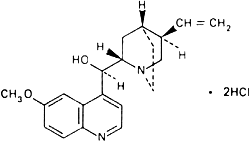Monographs: Pharmaceutical substances: Quinine dihydrochloride (Quinini dihydrochloridum)
Molecular formula. C20H24N2O2,2HCl
Relative molecular mass. 397.3
Graphic formula.

Chemical name. (8αS,9R)-6'-Methoxycinchonan-9-ol dihydrochloride; (8S,9R)-9-hydroxy-6'-methoxycinchonan dihydrochloride; CAS Reg. No. 60-93-5.
Description. A white or almost white, crystalline powder; odourless.
Solubility. Very soluble in water; soluble in ethanol (~750 g/l) TS; practically insoluble in ether R.
Category. Antimalarial drug.
Storage. Quinine dihydrochloride should be kept in a well-closed container, protected from light.
Additional information. Quinine dihydrochloride turns yellow on exposure to light. Even in the absence of light, it is gradually degraded on exposure to a humid atmosphere, the decomposition being faster at higher temperatures.
Requirements
Definition. Quinine dihydrochloride contains not less than 99.0% and not more than 101.0% of total alkaloids, calculated as C20H24N2O2,2HCl and with reference to the dried substance.
Identity tests
A. Dissolve 5 mg in 10 mL of water and add 0.05 mL of sulfuric acid (~100 g/l) TS; a strong blue fluorescence is produced (keep the solution for test B).
B. To the solution prepared for test A add 0.15 mL of bromine TS1 and 1.0 mL of ammonia (~100 g/l) TS; an emerald-green colour is produced.
C. Dissolve 0.05 g in 5 mL of water and add 1 mL of silver nitrate (40 g/l) TS; a white precipitate is produced.
D. A 20 mg/mL solution yields reaction A described under 2.1 General identification tests as characteristic of chlorides.
Specific optical rotation. Use a 30 mg/mL solution in hydrochloric acid (0.1 mol/l) VS and calculate with reference to the dried substance;  = -223° to -229°.
= -223° to -229°.
Clarity and colour of solution. Dissolve 0.20 g in 10 mL of hydrochloric acid (0.1 mol/L) VS; the solution is clear and not more intensely coloured than standard colour solution Yw2 when compared as described under 1.11.1 Colour of liquids.
Sulfated ash. Not more than 1.0 mg/g.
Loss on drying. Dry to constant weight at 105°C; it loses not more than 30 mg/g.
pH value. pH of a 30 mg/mL solution, 2.0-3.0.
Related cinchona alkaloids. Carry out the test as described under 1.14.1 Chromatography, Thin-layer chromatography, using silica gel R1 as the coating substance and a mixture of 20 volumes of toluene R, 12 volumes of ether R, and 5 volumes of diethylamine R as the mobile phase. Apply separately to the plate 4 μl of each of 4 solutions in methanol R containing (A) 10 mg of the test substance per mL, (B) 0.25 mg of quinine R per mL, (C) 0.25 mg of cinchonidine R per mL, and (D) 10 mg of the test substance dissolved in 1 mL of solution C. After removing the plate from the chromatographic chamber, allow it to dry in a current of air for 15 minutes and repeat the development. Heat the plate at 105°C for 30 minutes, allow to cool, spray with potassium iodoplatinate TS and examine the chromatogram in daylight. Any spot obtained with solution A, other than the principal spot, is not more intense than that obtained with solution B or solution C. Disregard any spot obtained with solution A immediately below the principal spot. The test is valid only if the chromatogram obtained with solution D shows two distinctly separated spots.
Dihydroquinine. Dissolve about 0.2 g, accurately weighed, in 20 mL of water. Add 0.5 g of potassium bromide R, 15 mL of hydrochloric acid (~70 g/l) TS, and 0.1 mL of methyl red/ethanol TS. Titrate with potassium bromate (0.0167 mol/l) TS until a yellow colour is produced. Add 0.5 g of potassium iodide R in 200 mL of water, stopper the flask, and allow to stand in the dark for 5 minutes. Titrate the iodine liberated by excess potassium bromate in the solution with sodium thiosulfate (0.1 mol/l) VS, adding 2 mL of starch TS when the solution has reached a light yellow colour. Each mL of potassium bromate (0.0167 mol/l) VS is equivalent to 19.87 mg of C20H24N2O2,2HCl, calculated with reference to the dried substance. Express the results of both the above determination and the assay in percentages. The difference between the two is not more than 10%.
Assay. Dissolve 0.150 g in 50 mL of dehydrated ethanol R and add 5.0 mL of 0.01 M hydrochloric acid. Carry out a potentiometric titration using sodium hydroxide (0.1 mol/L) VS, as described under 2.6 Non-aqueous titration. Read the volume added between the two inflexion points.
1 mL of 0.1 M sodium hydroxide (0.1 mol/L) VS is equivalent to 39.73 mg of C20H24N2O2,2HCl.
Additional requirement for Quinine dihydrochloride for parenteral use
Complies with the monograph for "Parenteral preparations".